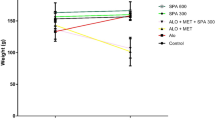Abstract
Clinical research has confirmed the efficacy of several plant extracts in the modulation of oxidative stress associated with hyperlipidemia and hyperglycemia induced by obesity and diabetes. Findings indicate that obtusifolin has antioxidant properties. The aim of this study was to evaluate the possible protective effects of obtusifolin against oxidative damage in diabetic hyperlipidemia and hyperglycemia. In this study, the rats were divided into the following groups with eight animals in each: control, untreated diabetic, three obtusifolin (10, 30, and 90 mg/kg/day)-treated diabetic groups. Diabetes was induced by streptozotocin (STZ) in rats. STZ was injected intraperitoneally at a single dose of 60 mg/kg for diabetes induction. Obtusifolin (intraperitoneal injection) was administered 3 days after STZ administration; these injections were continued to the end of the study (4 weeks). At the end of the 4-week period, blood was drawn for biochemical assays. In order to determine the changes of cellular antioxidant defense systems, antioxidant enzymes including glutathione peroxidase (GPx), superoxide dismutase (SOD), and catalase (CAT) activities were measured in serum. Moreover, we also measured serum nitric oxide (NO) and serum malondialdehyde (MDA) levels, markers of lipid peroxidation. STZ-induced diabetes caused an elevation (P < 0.001) of blood glucose, MDA, NO, total lipids, triglycerides and cholesterol, with reduction of GSH level and CAT and SOD activities. The results indicated that the significant elevation in the blood glucose, MDA, NO, total lipids, triglycerides and cholesterol; also the reduction of glutathione level and CAT and SOD activity were ameliorated in the obtusifolin-treated diabetic groups compared with the untreated groups, in a dose-dependent manner (P < 0.05, P < 0.01, P < 0.001). These results suggest that obtusifolin has antioxidant properties and improves chemically induced diabetes and its complications by modulation of oxidative stress.




Similar content being viewed by others
References
Baynes, J. W. (1991). Role of oxidative stress in development of complications in diabetes. Diabetes, 40, 405–412.
Kim, D. H., Hyun, S. K., Yoon, B. H., et al. (2009). Gluco-obtusifolin and its aglycon, obtusifolin, attenuate scopolamine-induced memory impairment. Journal of Pharmacological Science, 111, 110–116.
Yun-Choi, H. S., Kim, J. H., & Takido, M. (1990). Potential inhibitors of platelet aggregation from plant sources, V. Anthraquinones from seeds of Cassia obtusifolia and related compounds. Journal of Natural Products, 53, 630–633.
Genet, S., Kale, R. K., & Baquer, N. Z. (2002). Alterations in antioxidant enzymes and oxidative damage in experimental diabetic rat tissues: Effect of vanadate and fenugreek (Trigonellafoenum graecum). Molecular and Cellular Biochemistry, 236, 7–12.
Marklund, S., & Marklund, G. (1974). Involvement of the superoxide anion radical in the autoxidation of pyrogallol and a convenient assay for superoxide dismutase. European Journal of Biochemistry, 47, 469–474.
Aebi, H. (1984). Catalase in vitro. Methods in Enzymology, 105, 121–126.
Pieper, G. M., Jordan, M., Dondlinger, L. A., et al. (1995). Peroxidative stress in diabetic blood vessels. Reversal by pancreatic islet transplantation. Diabetes, 44, 884–889.
Hortelano, S., Dewez, B., Genaro, A. M., et al. (1995). Nitric oxide is released in regenerating liver after partial hepatectomy. Hepatology, 21, 776–786.
Bradford, M. M. (1976). A rapid and sensitive method for the quantitation of microgram quantities of protein utilizing the principle of protein-dye binding. Analytical Biochemistry, 72, 248–254.
Vornoli, A., Pozzo, L., Della Croce, C. M., et al. (2014). Drug metabolism enzymes in a steatotic model of rat treated with a high fat diet and a low dose of streptozotocin. Food and Chemical Toxicology, 70C, 54–60.
Yang, S. J., Je Lee, W., Kim, E. A., et al. (2014). Effects of N-adamantyl-4-methylthiazol-2-amine on hyperglycemia, hyperlipidemia and oxidative stress in streptozotocin-induced diabetic rats. European Journal of Pharmacology, 736C, 26–34.
Wang, L., Tian, W., Uwais, Z., et al. (2014). AGE-breaker ALT-711 plus insulin could restore erectile function in streptozocin-induced type 1 diabetic rats. Journal of Sexual Medicine, 11(6), 1452–1462.
Bullon, P., Newman, H. N., & Battino, M. (2014). Obesity, diabetes mellitus, atherosclerosis and chronic periodontitis: A shared pathology via oxidative stress and mitochondrial dysfunction? Periodontology, 2000(64), 139–153.
Conflict of Interest
The authors have on conflicts of interest to declare.
Author information
Authors and Affiliations
Corresponding author
Rights and permissions
About this article
Cite this article
Tang, Y., Zhong, Z. Obtusifolin Treatment Improves Hyperlipidemia and Hyperglycemia: Possible Mechanism Involving Oxidative Stress. Cell Biochem Biophys 70, 1751–1757 (2014). https://doi.org/10.1007/s12013-014-0124-0
Published:
Issue Date:
DOI: https://doi.org/10.1007/s12013-014-0124-0




